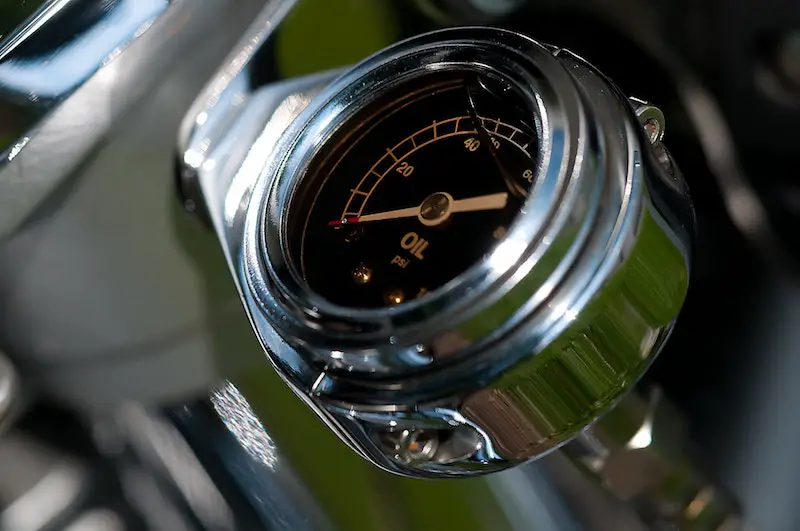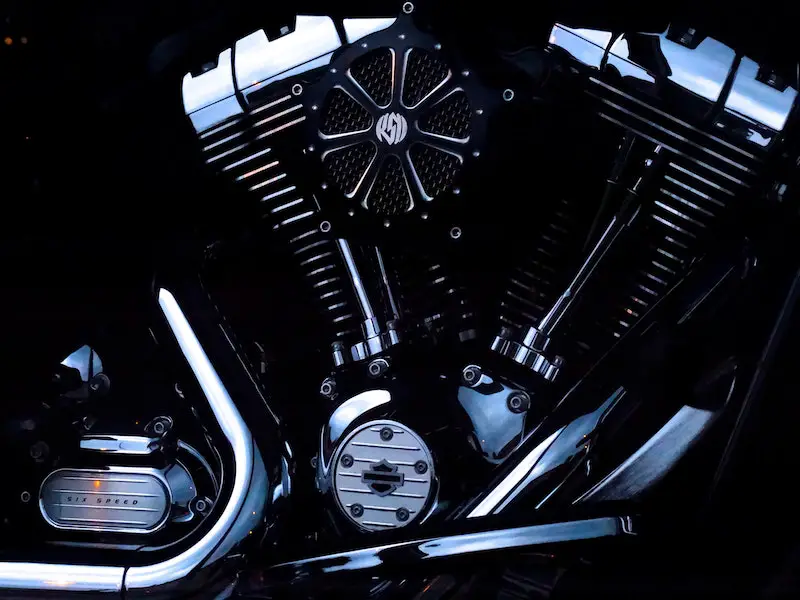Doing your own motorcycle maintenance, riding and maintaining your bike regularly is the best way to learn everything about your bike, including how to choose the best oil for your bike. It’s also going to help save you money and give you a better idea of how your motorcycle is supposed to run.
Changing the oil on your bike is one of the most frequent parts of maintenance you’ll have to perform to ensure proper lubrication of engine components. It’s likely that your local shop will charge upwards of $70 for this minor upkeep that’s easy to do on your own.
In this post, I want to talk about how often you should change your motorcycle oil, offering insights into when your bike is due for an oil change. This will give you have a better idea on how often it needs to be done. We’ll also take a look at some tips on choosing the right oil and how to inspect the current oil level.
Jump Ahead To:
How Often to Change Motorcycle Oil to Keep Your Bike Running Great
There are three things to keep in mind when it comes to how often to change motorcycle oil:
- The model of your bike
- How often you use your motorcycle (and in what conditions) influences when the oil should be replaced.
- The type of motorcycle engine oil you’re currently using
For bikes there are three types of engine oil – mineral oil, semi-synthetic oil, and fully synthetic motorcycle oil.
Different types of bikes will require different types of engine oil. While it’s possible to use a different type each time, depending on your bike, it’s a good idea to stick with the same type of oil for all of your maintenance purposes.
With a new motorcycle fresh from the dealer it likely comes with new oil and filter components. When you’re buying a used motorcycle it’s important to change the engine oil right away, despite what the seller says about it.
As for regular maintenance, your motorcycle user manual will give you the exact intervals when you’re supposed to change the oil. These can be anywhere between 500 and 5000 or more miles depending on the bike, indicating when you need an oil change. It’s a good idea to always refer to the service manual for maintenance manual that you have when it comes to maintenance questions and basic upkeep.
Using the proper kind of engine oil will prolong the life of your motorcycle engine. Your bike will also run smoother and be more enjoyable to ride when the oil is changed regularly. Avoid using the wrong engine oil, as this could damage your bike and lead to expensive repairs.
What’s the Purpose of Motorcycle Engine Oil?

The oil in your motorcycle engine is used to lubricate all of the moving engine parts. It also helps to clean the internal components and keep them from wearing out prematurely.
Every time the motorcycle is started and the engine is used, the oil helps to lubricate, clean, and protect all of the engine components. It’s needed for cold starts, high temperatures, rough riding, and everything in between. Engine oil is used to keep your bike running smoothly across all these conditions. The oil is known as the “lifeblood” of your bike and without it you’re in for a world of trouble.
Another major benefit to motor oil is that it’s used to keep your engine at reasonable temperatures. It absorbs the high temperatures that are created inside the motorcycle combustion chamber. This prevents the bike from overworking itself to keep cool and will lower the internal temperature of the motor, especially important if you frequently ride your motorcycle.
In the motorcycle world, engines that run at lower temperatures are more fuel efficient, quieter, and provide a smoother ride. Using the right kind of motorcycle oil will increase the lifespan of the engine and save you money on further maintenance costs.
If you don’t have your own user manual, or you’re not sure when to replace your motorcycle oil, this is the guide for you. Let’s take a look at how often to change motorcycle oil and how to inspect the oil level on your own bike.
How Often Should You Change Your Motorcycle Engine Oil?

The frequency of changing your motorcycle oil will depend on what type of oil you used for the last oil change and how long ago that change was.
It also helps to look at your motorcycle service or maintenance manual to see what’s recommended for your specific bike.
Keep in mind that your riding style plays a role in how often you should change your oil. Frequent hard acceleration, consistently high RPMs, or riding in harsh conditions can shorten oil life. If your riding style tends to be aggressive, consider slightly more frequent oil changes than the general guidelines suggest.
As for the oil used, each type has a different longevity.
Mineral-based motor oil, which is the most popular for motorcycles, should be changed at least every 2,000 miles or 3,200 kilometers. Riders that don’t see this kind of mileage should still change the oil at least twice per year (at the beginning and end of the riding season).
For bikes using semi synthetic motor oil, changing the oils are good idea at around 5,000 miles or 8,000 kilometers. This is a better quality, mid-range oil that’s suited for higher-end bikes.
With fully-synthetic motor oil you can stretch the frequency between oil changes up to between 7,000 and 10,000 miles (11,000 to 16,000 kilometers). This is the most expensive type of oil and it’s not necessary, or recommended, for every type of bike.
While semi-synthetic and fully-synthetic oils are more expensive, they will last longer in your bike before needing to be replaced. This will save you time from not having to do as many oil changes, as well as money in the long run.
Keep in mind that if you’re riding every day or commuting longer distances, you’ll want to follow a more rigorous oil change schedule, potentially changing your oil twice a year. It doesn’t matter the type of oil you’re using – you can never go wrong by keeping up with maintenance, knowing how often to replace your oil.
At any point if you discover that the oil is dirty or you notice a lack of engine performance, it’s a good idea to change the oil as soon as you can.
How to Tell if Your Motorcycle Oil is Dirty or Low

Every motorcycle lets you visually inspect the engine oil to determine its condition. It’s also possible to verify the oil level as it stands inside the crankcase on your bike, ensuring it’s not due for an oil change.
There are 2 main ways to inspect the oil depending on your bike, both essential for knowing when the oil should be replaced.
- Check the oil level dipstick.
Some bikes come equipped with a dipstick that can be pulled out for checking the oil (just like with a car).
Pull out and visually inspect the dipstick.
If the engine oil is dirty or watery then it’s time for an oil change.
With the dipstick you can also check the oil level.
Each dipstick is marked with a “high” and “low” level. Check that the oil level is between these two markings – if not, it’s time to change it - Look through the oil sight window.
Many motorcycles are equipped with a small sight window on the side of the crankcase.
There are usually “high” and “low” level markings on the sight window that tell you how much oil is remaining.
Through the window you can also visually inspect the quality of the oil. If the level is low or if the oil looks dirty it’s time to change it.
What Engine Oil Should You Use on Your Motorcycle?
The type of bike you have will determine the specific engine oil you should use and when you need to change my motorcycle oil.
Always refer to your owners manual or service manual for oil changes. You’ll find the best information in these books for your ongoing motorcycle maintenance, including recommendations on when to change your oil.
Otherwise, we recommend using semi-synthetic or fully-synthetic motor oils for most motorcycles. These last longer than mineral-based motor oils and are the best lubricant for modern motorcycle components.
Older bikes will perform better with mineral-based oils, which are made from refined crude oil. This type is thicker and performs better on older motorcycle engines with less precise parts.
Never hesitate to contact your local mechanic and always refer to your owners/maintenance manual if you’re ever in doubt.
Should You Change the Oil Filter for Every Oil Change?

Yes – it’s a good idea to change the motorcycle oil filter for every oil change you perform. Your specific bike owners manual or maintenance manual will recommend the specific intervals for changing the filter.
It’s the filter that keeps your oil clean and prevents dirty, debris, and small particles from getting into your engine. You don’t want these particles and debris damaging your motorcycle components and leading to bigger issues.
Regularly changing the oil, as well as the filter, will give you a smoother ride and increase the lifespan of your bike.
It doesn’t matter the type of oil you’re using, how often you ride, or in what conditions. Get into the habit of changing the filter whenever you change the oil. You wouldn’t want clean, fresh oil running through the old filter that’s already filled with dirt, debris, and unwanted particles.
Do You Need to Change Your Motorcycle Oil Every Year?
While it would be nice to change your motorcycle oil every year, it’s not necessary unless you’re doing the mileage that we mentioned above.
Those of you riding a few hundred or just a few thousand miles every year probably won’t need to change the oil every year. This is probably overkill, although it wouldn’t hurt to change it before putting your bike away for the winter.
Considering how cheap oil changes are, especially if you’re doing it yourself, it’s a good idea to change it every year if you have the time, energy, and budget to do so.
Obviously, if you’re riding a lot of miles, you would want to follow what your Motorcycle Maintenance manual recommends, especially in terms of how often to change your motorcycle oil.
How Long Does Synthetic Oil Last in a Motorcycle?
Synthetic oil will last up to 10,000 miles on most motorcycles, making it a critical choice for those looking to extend the times between needing to change my oil.
If you’re using a mineral-based oil, you will want to change it much more frequently than if you were using a fully synthetic oil.
As always, refer to your owner’s manual for the exact oil change intervals. It’s also important to remember that synthetic oils will last longer and you can push them a bit further than for a traditional motorcycle oil.
How Often Should You change the Oil on a Harley Davidson?
Those of you with Harley Davidson motorcycles will want to refer to your owner’s manual or the maintenance schedule when it comes to how often you should change the oil on a Harley-Davidson.
Typically, every 3000 to 4000 miles is the recommended mileage.
While the above intervals are good guidelines, it’s important to consult your owner’s manual for your specific motorcycle. For example, newer Harley-Davidson models may recommend oil changes closer to every 5,000 miles.
You could always contact your mechanic or your local Harley dealer for some better advice and their recommendations on Harley-Davidson oil change intervals.
Oil Changes and Seasonal Storage
If you store your motorcycle for extended periods, like over winter, it’s wise to change the oil beforehand. Old oil can collect moisture and contaminants during storage, potentially leading to internal engine corrosion.



